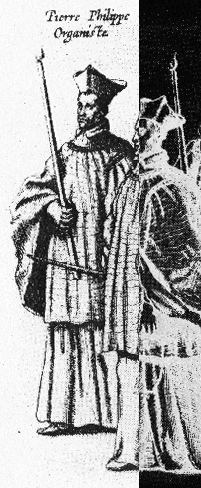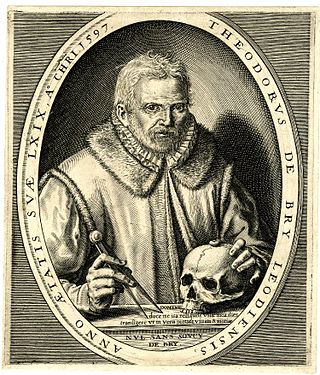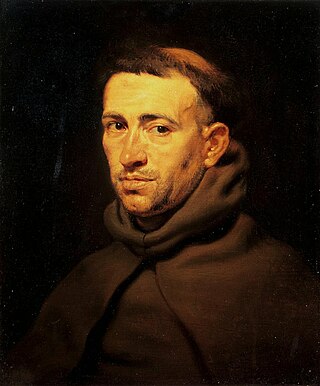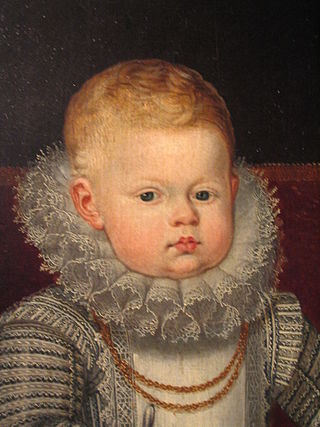Related Research Articles
Martin Anton Delrio SJ was a Dutch Jesuit theologian. He studied at numerous institutions, receiving a master's degree in law from Salamanca in 1574. After a period of political service in the Spanish Netherlands, he became a Jesuit in 1580.

Isabella Clara Eugenia, sometimes referred to as Clara Isabella Eugenia, was sovereign of the Spanish Netherlands, which comprised the Low Countries and the north of modern France with her husband, Archduke Albert VII of Austria.

Henri II de Bourbon, Prince of Condé was the head of the senior-most cadet branch of the House of Bourbon for nearly all his life and heir presumptive to the King of France for the first few years of his life. Henri was the father of Louis, le Grand Condé, the celebrated French general.

Philip William, Prince of Orange was the eldest son of William the Silent by his first wife Anna van Egmont. He became Prince of Orange in 1584 and Knight of the Golden Fleece in 1599.

Peter Philips was an eminent English composer, organist, and Catholic priest exiled to Flanders in the Spanish Netherlands. He was one of the greatest keyboard virtuosos of his time, and transcribed or arranged several Italian motets and madrigals by such composers as Lassus, Palestrina, and Giulio Caccini for his instruments. Some of his keyboard works are found in the Fitzwilliam Virginal Book. Philips also wrote many sacred choral works.

Theodor de Bry was an engraver, goldsmith, editor and publisher, famous for his depictions of early European expeditions to the Americas. The Spanish Inquisition forced de Bry, a Protestant, to flee his native, Spanish-controlled Southern Netherlands. He moved around Europe, starting from his birth on the city of Liège in the Prince-Bishopric of Liège, then to Strasbourg, Antwerp, London and Frankfurt, where he settled.
Shane O'Neill, 3rd Earl of Tyrone was the youngest son of Hugh O'Neill, Earl of Tyrone.

Princely Count Charles of Arenberg, duke of Aarschot, baron of Zevenbergen, knight of the Order of the Golden Fleece, was the second Princely Count of Arenberg and a leading aristocrat of the Habsburg Netherlands, who served as a courtier, soldier, minister and diplomat.

Juan Alfonso Enríquez de Cabrera y Colonna, 5th Duke of Medina de Rioseco,, he was hereditary 9th Admiral of Castile, and the 8th Count of Melgar.

Hendrik Hondius I was a Flemish-born and trained engraver, cartographer, and publisher who settled in the Dutch Republic in 1597.

Lamoral, 1st Prince of Ligne was a diplomat in the 17th century.

Rutger Velpius was a 16th- and 17th-century printer and bookseller. He was the first printer in the city of Mons, and later became printer to the court in Brussels. His career coincided closely with the first decades of the Dutch Revolt
Henricus Calenus or Henri van Caelen (1583–1653) was a clergyman in the Spanish Netherlands, closely involved in the early history of Jansenism.

Andres de Soto or Andreas a Soto (1552/3–1625) was a Franciscan preacher and spiritual writer, confessor to the Infanta Isabella Clara Eugenia.
Nicolas de Montmorency, count of Estaires, was an office holder and spiritual author in the Spanish Netherlands.
Guillaume de Bette, 1st Marquess of Lede, Baron of Péronne, Lord of Impe, Knight of Santiago, was a military commander and diplomat from the Spanish Netherlands.

Philip Rubens (1574–1611), was a Flemish antiquarian, librarian, philologist and city administrator from the Habsburg Netherlands. He was the older brother of the prominent Flemish Baroque painter Peter Paul Rubens.
Francesco Sacrati was a Roman Catholic prelate who served as Archbishop of Cesena (1622–1623), Cardinal-Priest of San Matteo in Merulana (1621–1623), and Titular Archbishop of Damascus (1612–1622).

Alonso of Spain was an infante of Spain, who died in childhood.
References
- ↑ Émile Van Arenbergh, "Hornkens (Henri)", Biographie Nationale de Belgique , vol. 9 Archived 2016-12-27 at the Wayback Machine (Brussels, 1887), 519.